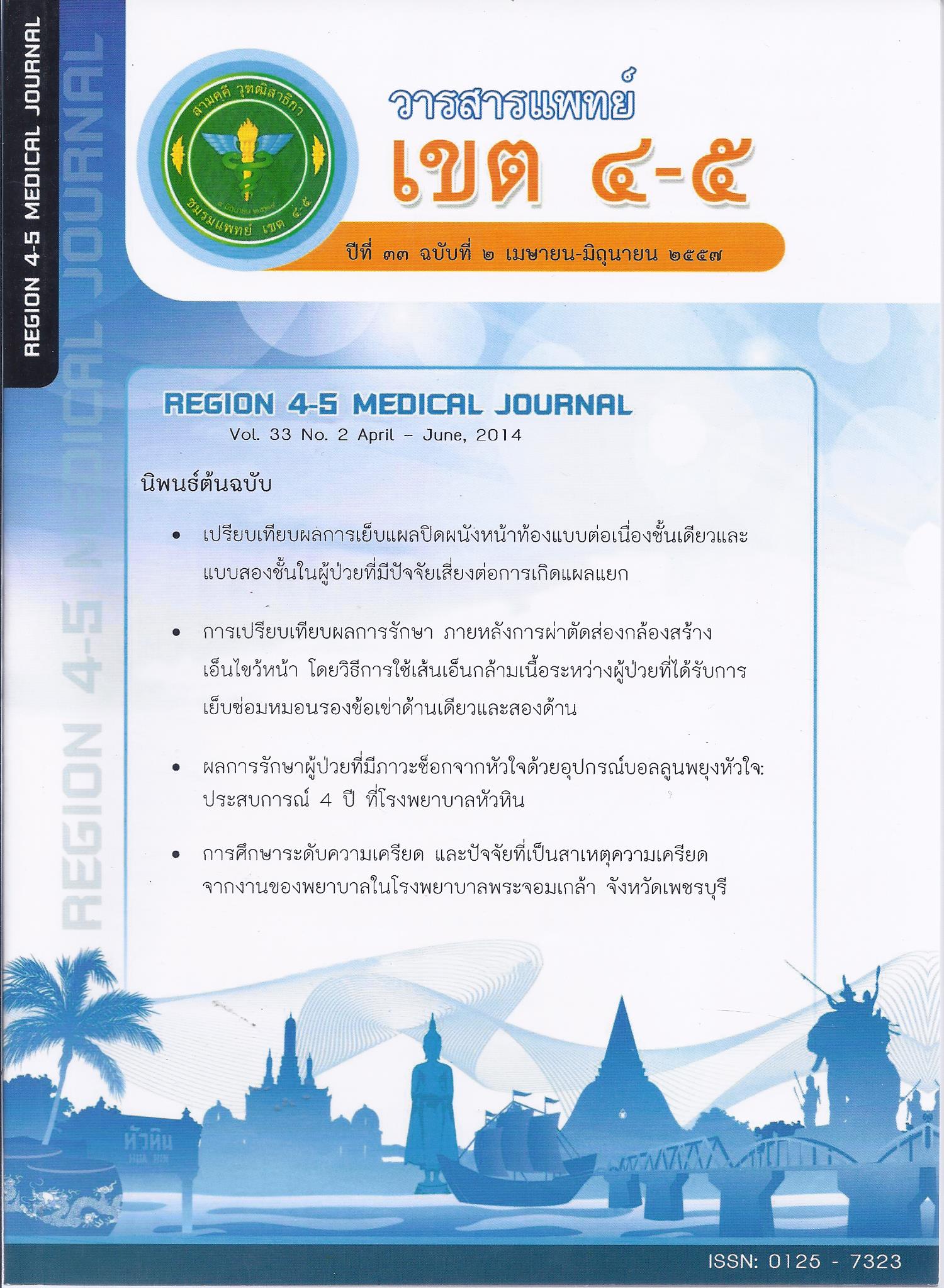เปรียบเทียบผลการเย็บแผลปิดผนังหน้าท้องแบบต่อเนื่องชั้นเดียวและแบบสองชั้นในผู้ป่วยที่มีปัจจัยเสี่ยงต่อการเกิดแผลแยก
บทคัดย่อ
Objective: Comparative study of abdominal wall closure by continuous single layer closure versus two layer closure in patients with the risks of abdominal wound dehiscence, by follow up wound separation occurrence and studying the risk factors affecting wound separation occurrence.
Materials and method: A prospective study among of three hundred patients who underwent midline exploratory laparotomy who had risks of wound dehiscence at Damnoensaduak Hospital during January 2003 to august 2011. These patients were divided into two groups by randomly selected from sealed envelopes. 145 patients in control group had Their fascial wounds sutured by continuous method as normally, while 155 patients in experimental group had their fascial wounds sutured by two layers suturing method. By comparing results of wound dehiscence occurred, mortality rate, complications, hospital stay and cost of treatment. Other risk factors that affect wound dehiscence were analyzed by chi-squre test, t-test and multiple logistic regression.
Result: 56.7 % of patients were male. Experimental group compared with the control group, mean age 61.82 years and 61.27 years. Comorbidity disease and risk factors before surgery did not differ. There was only higher rate of obesity (BMI > 25) in experimental group than control group (p = 0.41). In experimental group there was one patient with wound dehiscence, compared to 15 patients in control group which was statistically significant, p = 0.001 (RR 17.76, 95%CI 2.31 - 136.33). Hospital length of stay in experimental group was 11.10 ± 3.78 days and 12.28 ± 5.11 days in control group, which was also statistically significant (p = 0.025). The period of wound healing in experimental group was 11.11 ± 2.40 days and 12.25 ± 3.67 days in control group, which was statistically significant (p = 0.002). Mortality rate in control group results in 4 patients died, while there was none in experimental group, but no statistical significance. Incisional hernia occurred in 2 patients in each group. Several factors were found to be statistically significant by multiple regression analysis (p < 0.05) in abdominal wound dehiscence as follow : Leakage of visceral organ was most risk, 21.16 times (OR = 21.16, 95% CI 3.42 - 130.66) p = 0.001; followed by hypoalbuminemia, 19.87 times (OR = 19.87, 95% CI 3.33 - 118.72) p = 0.001; congestive heart failure, 14.78 times (RR = 14.78, 95% CI 2.30 - 95.09) p = 0.005 and wound infection, 12.96 times (OR = 12.96, 95% CI 2.71 - 62.06) p = 0.001.
Conclusion: Two layer sutures technique decreases the chance of wound dehiscence in the patients with highrisk. Identifying and control risk factors pre-and post-operation were contributed to the better outcomes which help improve overall treatment.
ดาวน์โหลด
เผยแพร่แล้ว
รูปแบบการอ้างอิง
ฉบับ
ประเภทบทความ
สัญญาอนุญาต
ลิขสิทธิ์บทความเป็นของผู้เขียนบทความ แต่หากผลงานของท่านได้รับการพิจารณาตีพิมพ์ลงวารสารแพทย์เขต 4-5 จะคงไว้ซึ่งสิทธิ์ในการตีพิมพ์ครั้งแรกด้วยเหตุที่บทความจะปรากฎในวารสารที่เข้าถึงได้ จึงอนุญาตให้นำบทความในวารสารไปใช้ประโยชน์ได้ในเชิงวิชาการโดยจำเป็นต้องมีการอ้างอิงถึงชื่อวารสารอย่างถูกต้อง แต่ไม่อนุญาตให้นำไปใช้ในเชิงพาณิชย์




